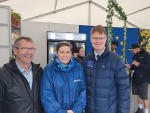Despite a tough year or two for dryland farmers in North Canterbury, Hawarden Suffolk stud breeder Penni Loffhagen is philosophical.
"The January rains were great. It was about as much as we'd got for the previous 12 months. We don't have any permanent streams so we're grateful the council water scheme has kept us going through the drought."
Loffhagen is a third-generation Suffolk breeder and, with her partner Rocci Scott, runs Tawhai Suffolk Stud on 230ha that she describes as running "from hill country to swamp".
With 570 recorded ewes and 125 ram hoggets and 125 ewe hoggets, Tawhai is one of the country's biggest Suffolk studs. It's also a high-performing venture, with one of its rams crowned Supreme Champion at the 2014 Canterbury A&P Show.
Loffhagen started the stud in 1989 and has been on her current farm for 20 years.
She says their breeding programme favours a rangy animal that has a strong back end with "more roast". She stays well connected to end users through a local butcher who supplies Canterbury restaurants. This gives her a good feel for what consumers want when it comes to breeding a terminal sire.
In recent times she has also started selecting for resilience to footrot: six of her stud rams have a very low (desirable) score for the trait.
The hardiness of the Suffolk breed's forbears and the challenging environment in North Canterbury combine to produce sheep that will do well in most situations. That's a useful attribute because there's strong demand for rams and ewes from Tawhai from all over New Zealand.
They go as far south as the Mackenzie Basin, over to the West Coast and up to Blenheim in the South Island. They're also sought after in the North Island with rams being sold through the Feilding stud fair and a couple also going to Latin American buyers recently.
Loffhagen is keen to see the animals doing well in their new homes and they usually do, but about five years ago she started receiving reports from West Coast commercial flock owners of losses due to sudden death from clostridial disease among Tawhai Suffolks they had purchased.
"We've always used a five-in-one vaccine but it clearly wasn't doing the job for that environment."
Loffhagen suspects a change to lusher feed on the Coast may have played a part. She was determined to prevent sudden deaths among these valuable animals and after consulting her veterinarian she switched to a 10-in-one clostridial vaccine, Covexin 10.
"We've had no more clostridial-related losses since we made the change," Loffhagen says.
Since moving to Covexin 10, she's been advocating for the 10-in-one option and encourages her customers to keep the animals and their progeny protected this way. The vaccine provides active immunisation of sheep and cattle against diseases caused by Clostridium perfringens types A, B, C, and D, C. chauvoei, C. novyi, C. septicum, C. tetani, C. sordellii, and C. haemolyticum.
"These are valuable animals and it's sensible [prevention]," she says.
Lambs, which can be vaccinated any time from two weeks of age, are given their sensitiser shot at tailing and the booster four-six weeks later at weaning. Previously vaccinated ewes are given their annual booster two-six weeks before lambing. Loffhagen makes sure lifestyle block owners who buy their ewes and lambs understand the vaccination programme with Covexin 10.
She says the availability of the vaccine in 100-shot packs is ideal for their operation. Lambing, a labour-intensive period on a stud, is spread out from July to September, so the smaller pack sizes are useful.
"It's also great for veterinarians servicing small block owners who might only have a few sheep to vaccinate at a time."
With the drought at least pausing, if not totally broken, Tawhai is enjoying decent autumn growth and they are taking the opportunity to redevelop pastures decimated by the 18-month dry spell.
Mating is under way and Loffhagen is hoping to improve on last year's 186% lambing. This productivity allows them to cull intensively. Changing to a 10-in-one clostridial vaccine, she says, ensures that the animals that do make the cut can reach their potential.











